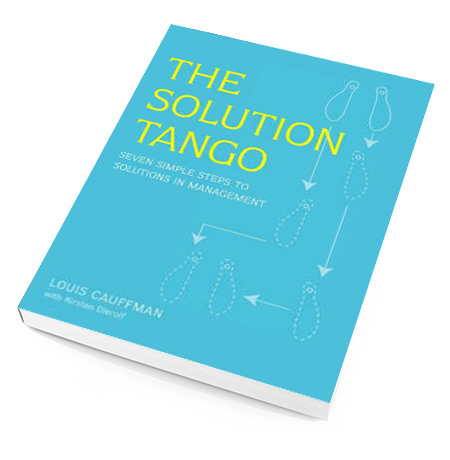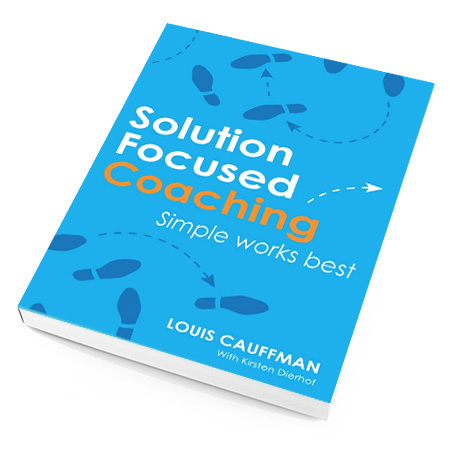Episode 14 – The Man in the Middle: A Solution Focused Feuilleton
Steve: “Now Peter, let’s talk about how you will handle the problem with John.”
Peter: “I’ll do my best.”. Avoiding each other doesn’t help us much.”
Steve: “True. In our previous meeting you told me that you under- stand his position a lot better than before. You realized that John has a lot on his mind. After all, he is fairly new to this company and he has to prove himself.”
Steve carefully chooses his words. He quotes Peter from the previous meeting. It was Peter who suggested the hypothesis that insecurity and lack of experience may account for John’s overly controlling behavior. Therefore, John’s behavior is not so much a direct personal attack on Peter but more a personal issue for himself. If Peter can feel that John’s behavior is no attack, he will no longer be tempted to defend himself. Instead of resisting John, he can start cooperating with him.
Peter: “That’s true but it doesn’t allow him to treat me the way he has been treating me up to now.”
Steve: “I understand. Wisdom comes with age.”

Peter said that he himself had been insecure in the beginning of his career and that he behaved like John in those days. The expression that “wisdom comes with age” contains a subliminal compliment to Peter. It implies that Steve sees Peter as a person with experience and self-confidence. This simple sentence invites Peter to use his wisdom to solve the problem at hand.
By the way, you probably noticed that Steve said: “I understand” and not “I agree.” Do you see the difference? Steve wants to make sure that he never gives Peter the impression that he favors him over John. Yet Steve acknowledges what Peter says. This again shows Steve’s linguistic art in using solution talk. We don’t need many words to say a lot!
Peter: “Thanks. What’s your suggestion?”
Steve: “None. I prefer your own suggestion from our last meeting. Last time you explained to me that you had found an elegant way of killing two birds with one stone.”
Peter: “What do you mean?”
Peter is not using his own resources and therefore is on the buyer position. Steve gives advice by using information that comes from Peter himself.
Steve: “You told me that you could do two things at a time. While at the same time keeping him informed about the positive progress you and your team make, you can slip in minor problems for which you ask for his advice. That way John will have a finger in the pie without interfering too much.”
Peter: “Isn’t that unethical?”
Steve: “Not necessarily. It’s not like you are cheating John or the company. On the contrary, this requires you to make the first step. You have to take the initiative to go and talk with him.”
Peter: “I see. So maybe I have to find a neutral topic to talk about.”
Steve: “Maybe. But why beat around the bush? Both of you have more than enough topics to talk about. Maybe your contractor bonus idea is a good starter. You could work out this idea together with someone from your team. In order not to confront John with a fait accompli, you might present him this plan with some gaps in it and ask him for supervision. That way, he gets a chance to add some of his own ideas and the plan becomes a joint plan.”
Peter: “I think John will be more likely to accept the plan if I work it out in concrete numbers. I’ll calculate the estimated costs and profits of the proposal. I’ll also calculate the cost of carrying out the project the traditional way. Then John can compare both results. If I can get him interested enough, I’m pretty sure that he can and will add interesting points of view.”
Peter picks up on the suggestion and is now using his own resources: he is in the co-expert position. Steve only needs to encourage him to do more of the same that works.
Steve: “Correct. If you can show him hard data that supports the new method, chances are high that he will buy into it. You know that John is always interested in something new, and you know his remarks about ‘dinosaurs’.”
Peter: “OK, I will give it a try. I believe he might buy into my new method but only if he sees the hard data. However, cooperating with me, now that’s an entirely different matter. Certainly, after the mess we made of our ‘cooperation’ during the last few weeks. How on earth will I get cooperation from John?”
Steve: “That might be pretty simple, although it won’t be easy. Again, you will need to take the first step. You could start off the meeting by telling him that you are convinced that his contribution and improvements will be essential for the success of the plan. That would be a nice compliment, don’t you think?”
Peter: “Yes. Plus, it shows John that I am willing to bury the hatchet. Actually, it will not be that difficult because I really think that his contribution is valuable.”
Steve: “When you do this, you are already cooperating.”
Peter: “Good idea, I can use your T.E.A.M. concept. Solutions Focus will gain from this, as we all will. This is an elegant solution that won’t oblige me to go down on my knees before John.”
Steve: “Sure Peter, no use for that. This is not about going down on your knees for each other but about cooperating for results. You can be sure that the board will appreciate and endorse your joint project plan. Good work and good luck.”
The outcome
The weeks go by in a mad rush. Peter makes a habit of saying “Hi” to John every morning. Initially John was surprised by Peter’s friendly behavior, but he really appreciated it and told Peter so.
Over the course of three Saturday morning meetings, Peter finalizes his plan with the help of some of the new employees. Then he invites John to have a breakfast meeting, saying that he needs John’s supervision with some matters. This meeting goes smoothly and is very successful. Both are pleased and surprised to find that they are able to talk to each other in an entirely different style than before. Steve is updated over the telephone. He receives the project plan by mail and is pleased to note that both men signed the document.
The evening of their last scheduled meeting, Peter calls Steve at home to cancel and apologizes for canceling so late. He tells Steve that John has invited him to come along on a working visit to a sister company. Steve congratulates Peter on the project plan and on the cooperative style that he and John have developed. When Steve asks if Peter thinks it necessary that they meet again, Peter says, “I don’t think so. We are all set, and I can manage on my own. But thanks for the help.” In the following months John and Peter slowly but gradually replace their battle with a growing mutual respect. They never became best friends, but that isn’t really necessary anyway. As long as they respect each other as colleagues they can work together successfully.
‘The Man in the middle’ is an excerpt from the book ‘The Solution Tango’ (and ‘Solution Focused Coaching’ e-book) by Louis Cauffman. This book presents a new approach to conquering the numerous challenges, problems, and failures that managers encounter at work, many of which are people-related. An important lesson identified in the book is that a manager must act as both the leader who provides direction for a team or company and as the coach who enables others to make the most of their skills, enabling the individual and the organization to succeed. A seven-step framework to enhance problem-solving capabilities, examples and tips, and a survival kit for sinking managers will help managers improve their people skills and learn how to approach everyday issues from a positive perspective.
 LOUISCAUFFMAN.COM
LOUISCAUFFMAN.COM
